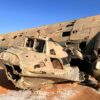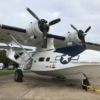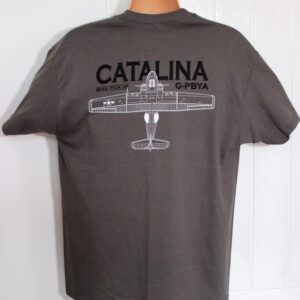Yet again we have a surprising amount of news about surviving Catalinas around the globe.
What was to be our opening ‘good news’ story rapidly turned into the complete opposite as widely reported in the aviation press and on the internet! PBY-6A N85U was the last working water bombing Catalina in the world and until not so long ago was still fighting fires in the north-west USA from its base in Washington State. Following retirement it flew a few airshows and was then selected to appear in a leading role in the film USS Indianapolis – Men of Courage ‘co-starring’ Nicholas Cage. When finished, the film will commemorate the wartime rescue of 56 survivors from the sea after the US ship was sunk by a Japanese sub’ at the end of July, 1945. After some maintenance, N85U flew to Pierce County Airport – Thun Field in Washington and was repainted to vaguely resemble the original Catalina BuNo 46472 of VPB-23. In late-June it flew down to Mobile, Alabama where filming was scheduled. So far, so good! On June 29th the Catalina landed on the sea off Orange Beach, Alabama and, not long after, started to take on water in the forward hull area, allegedly because some hull drain plugs were not in place. The crew taxied to shore close to the Flora-Bama lounge resort and put the undercarriage down but could not exit the water and eventually the bow became embedded in the sand. An attempt to pull the Catalina onto the beach using tractors and cables failed when the cables snapped.

There are many photos on the internet of N85U’s demise in Alabama. Here is a photo in happier times just after it’s re-spray as BuNo 46624 at Thun Field, WA. Photo: Bill Bailey
At this point the Catalina was complete and essentially undamaged apart from the ingress of salt water but gradually things started to go wrong. As the sea began to give the bow section a pounding and bemused tourists looked on, a decision was made to tow the Cat’ out to sea and recover it using a salvage crane and barge. What followed caused much comment and speculation on the internet but the end result was that the airframe was torn to pieces by the lifting strops and ended up as a pile of scrap on the barge. A very sad end to a fine aircraft and an interesting project. The wreck has been acquired by a local museum – more news on that next time…..
Fortunately there is better news from the USA concerning a number of airworthy and non-airworthy Catalinas so I’ll start with Model 28-5ACF N206M, originally built by Consolidated in San Diego for the Royal Canadian Air Force (RCAF) as a Model 28-5AMC and known in military service as a Canso A. In a long career that also saw it fly as a transport in Canada and a water bomber there and in Spain it later ended up in storage at Greybull, Wyoming before heading back south to Bloomington, Indiana where it is now owned by Black Cat Aviation LLC. Dennis Eiler is one of its pilots and reports that it is now airworthy again and flew back to Greybull for inspection plus some engine and passenger interior work in late-June before returning to its Bloomington base. Although currently in rather austere black livery this aircraft is notable for having a fine set of rear-hull blisters and an eye-ball bow turret…..
Not so long ago former-RCAF Canso A N249SB was languishing at Nanaimo on Vancouver Island, British Columbia awaiting a very uncertain future. It was saved and with borrowed engines and crudely covered blister apertures it was flown to McMinnville, Oregon for the Evergreen Aviation & Space Museum. It was restored for on-going static display and painted as a US Navy PBY-5A of VP-44 but now, due to big changes going on there, the Catalina has been put up for sale through Air Assets International. The Cat is described as ‘flyable’. It has a very similar history to our own Miss Pick Up and served with many of the same commercial owners until going into storage at Nanaimo.
Another San Diego-built aircraft is Canso A N68740, originally 9742 in RCAF service and converted for civilian use many years ago. It has spent the last couple of decades and more with the Lone Star Flight Museum at Galveston, Texas as a static exhibit. Although kept under cover, it was damaged by Hurricane Ike on September 13th, 2008. It seems that the museum has now decided to dispose of the damaged but complete airframe and it has been reported as sold to the Pima Air & Space Museum, Tucson, Arizona this summer. This is interesting inasmuch as there are already four Catalina hulls at the museum in Pima. The four vary in condition from fair to wreckage and it was understood that these would be used to produce one display standard hull. Quite what will happen to them now that N68740 is being acquired is not known at this stage.

N206M photographed at Rapid City Regional Airport, South Dakota earlier this year. Photo: Dennis Eiler
Up in Washington State, the Wright Cyclone-powered Super Cat N9505C has been stored at Ephrata for some years and not shown much sign of being restored to airworthy condition. A former US Navy PBY-5A (BuNo 34027) it was used as a water bomber in the SLAFCO fleet until retirement. A recent post on our Catalina Society website suggested that work was going to start this summer on getting it up to fully airworthy passenger certification. More news as and when we get it.
In our last edition, I noted that Canso A C-FUAW was ending its restoration period and was being repainted in RCAF livery as 11042/K, its original identity. This was completed in the summer and it flew again at Victoria, BC, attending its first air show on August 8th/9th when it flew to Abbotsford on BC’s mainland.

Canso A C-FUAW has now been fully painted to represent its RCAF period when it was serial 11042/K. It is shown here taxying out at Victoria, BC on August 5th. Photo: Tim Martin
Now US registered but based in Greece is N315KM, once a Canso A but recently converted to TC-785 standard with new horn balance rudder. The aircraft is in very good condition and has undergone much maintenance in recent months although it has not flown for some years. Flight has come a step further however and engine runs were carried out at its Tatoi, Athens base in late-July.
Also in Europe is EC-FMC, built as a tall-tailed PBY-6A but converted to a PBY-5A many decades ago after being sold by the US Navy. For some years it was used as a fire fighting water bomber and its last contracts were in Spain and Portugal. After retirement it was acquired by David Pajus who intended to restore it to airworthy condition and base it in his native Sweden. However, prolonged legal issues with the previous owner delayed the process and David has now decided to give up and dispose of the aircraft. I wonder where it will end up?
Another illustration of the relative ease with which a Catalina can be acquired but the difficulty in then getting it flying again is the Catalina Flying Memorial’s PBY-6A VH-CAT at Bankstown, New South Wales. It arrived in Australia from Portugal in late-2008 and has consumed a lot of cash since but flight is still some way off. According to a recent newspaper interview with Phil Dulhunty, CFML Chairman, a further A$85,000 is needed for certification and some A$650,000 is owed to creditors. On-going work continues both to gain sponsors and to reach an airworthy state. A major step on the way occurred in June when the engines were run for the first time since work started on restoration, a smoky event according to reports!
In Queensland, the PBY-6A VH-EAX owned by the Qantas Founders Museum at Longreach has been re-painted to resemble G-AGIE Antares Star/’4’ one of the five Catalinas flown on the wartime Double Sunrise service between Ceylon and Perth, WA. Although now grounded, the museum piece has been rigged up with an internal sound system so that visitors can experience something of the sound inside a flying Catalina! The museum is to be applauded for rescuing the aircraft and putting it on display. Good effort!

















